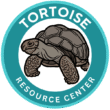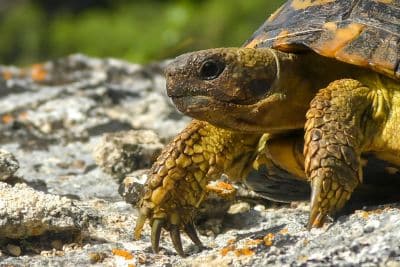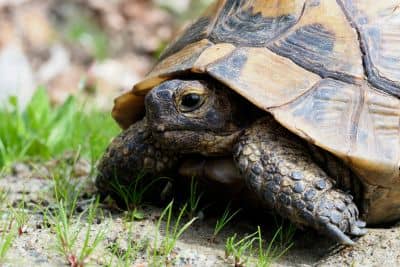Also known as yellow tortoises, elongated tortoises (Indotestudo elongata) are not only interesting to look at, they also make great pets for dedicated keepers. While very rare in the wild (they’re listed as critically endangered by the IUCN Redlist of Threatened Species), captive-bred individuals are readily available on the commercial reptile market.
However, to successfully maintain this species, keepers will need to establish a proper habitat, provide appropriate environmental conditions, and offer a nutritious diet.
In this article I’ll be identifying some of the key husbandry requirements owners will have to satisfy and share some basic tips for keeping your elongated tortoise healthy. Read on to find out more!
Elongated Tortoise Enclosures
A proper enclosure and the correct environmental conditions are vital for successfully maintaining an elongated tortoise. But the first thing owners will need to consider is whether they’ll be maintaining their tortoises indoors or outdoors.
Indoor vs Outdoor Maintenance
There are several key differences between keeping your tortoise indoors or housing him in an outdoor enclosure. Both offer a different set of benefits and drawbacks, and neither option is the best choice in all situations.
- Indoor housing: Keeping your tortoise indoors allows you to control the temperature and humidity level more accurately, but it also means that you’ll have to provide special lighting to ensure your pet stays healthy. Additionally, it’s often difficult to provide sufficient space in an indoor environment.
- Outdoor housing: Because outdoor tortoise enclosures receive natural, unfiltered sunlight, they alleviate the need for special lighting. But outdoor enclosures must usually be custom-built, and your pet will be exposed to a variety of threats, ranging from inclement weather to predators.
On balance, outdoor housing is likely preferable when possible, but plenty of keepers have managed to successfully maintain tortoises indoors for long periods of time.
Housing Requirements
There are a number of different enclosure types you can use for elongated tortoises, including:
- Commercially produced tortoise “tubs” or “tables”: These tubs and tables serve as the easiest way to house young elongated tortoises, as they’re specifically designed for tortoise maintenance and require little modification. However, they’re generally not available in sizes large enough for adults.
- Stock tanks and children’s swimming pools: An affordable option, these types of enclosures are sometimes available in sizes that would accommodate adults, and they’re often somewhat affordable. The drawback of these enclosures is that they will often require extensive modification to make them suitable for tortoise maintenance.
- Front-opening reptile enclosures: Though often pricey, front-opening reptile cages can make suitable habitats for tortoises. They’re rarely large enough to work for adult elongated tortoises, but they can make excellent enclosures for juveniles. However, you may need to block the bottom portion of the glass doors, as transparent materials can cause stress and confusion for chelonians.
- Custom-built enclosures: Most keepers will find that custom-built enclosures are the only realistic option for the maintenance of adult tortoises. Building your own enclosure requires considerable skill and some tools, but you can design the enclosure to meet your specific needs.
No matter which type of enclosure you choose, it’s imperative that you provide your pet with sufficient space. As a rule of thumb, you’ll want to provide elongated tortoises with enclosures measuring at least 6 feet long and 6 feet wide. However, these are sometimes active tortoises who’ll appreciate and use enclosures measuring twice this size.
This illustrates part of the reason that outdoor maintenance is likely the most popular option among keepers – it’s simply easier to provide this much space outdoors.
Environmental Conditions
Once you’ve decided on the proper type of enclosure for your elongated tortoises, you’ll need to provide the appropriate environmental conditions, including the proper temperature, humidity, and lighting.
Temperature
Elongated tortoises require a thermal gradient. This essentially means that you’ll need to set up a range of temperatures inside the enclosure. You can do this by clustering all the heating devices at one end of the enclosure (if you’re housing your pet outdoors, it means you’ll need to provide areas that are drenched in strong sunlight, as well as areas with deep shade).
There are two types of heating devices that will work, and both have their share of benefits and drawbacks:
- Heat lamps: Heat lamps are generally pretty affordable, and some also provide the kind of full-spectrum lighting tortoises require (more on this later). However, they don’t work well with thermostats, so it can be challenging to adjust the temperature – you’ll often need to simply purchase lights of different wattages and experiment.
- Radiant heat panels: Radiant heat panels cost more than typical heat lamps, but when used in conjunction with a thermostat, you can enjoy precise temperature control. Radiant heat panels do not provide visible light, so they must always be used alongside other lighting devices (such as fluorescent tubes).
Humidity
As with the enclosure temperatures, you’ll want to provide a range of humidity levels for your elongated tortoise. Generally speaking, this will mean allowing the warm side of the enclosure to remain relatively dry (though not truly arid), while keeping the cool side of the enclosure quite humid (though never wet).
To accomplish this, you’ll likely need to mist the cool side of the enclosure with room-temperature water once or twice each day.
Are You Starving Your Tortoise?
Save 10% on premium tortoise food and supplements from Tortoise Resource Center on Amazon now using code BUYNOWGET10
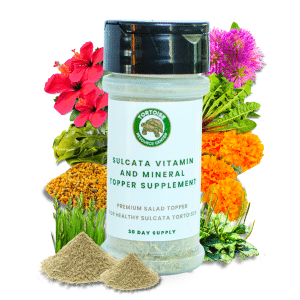
Sulcata Vitamin & Mineral Topper Supplement
30-Day Supply | 2 oz (56 g)
$24.99
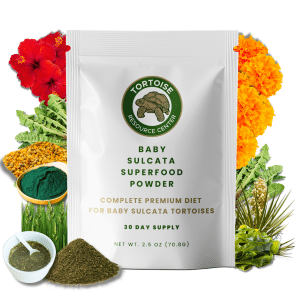
Baby Sulcata Tortoise Superfood Powder
30-Day Supply | 2.5 oz (70.8 g) Bag
$24.99
Lighting
Elongated tortoises require access to full-spectrum lighting, which includes light in the UVB portion of the electromagnetic spectrum. There are three basic ways you can achieve this:
- Maintain your tortoise outdoors, where the sun will provide all the UVB light he needs. This is the easiest and most ideal way to satisfy your pet’s lighting needs.
- Install full-spectrum fluorescent or LED lights on the enclosure. Fluorescent lights and LEDs are often very affordable, but they do not produce heat, so you’ll still need to install heating devices.
- Install mercury vapor bulbs designed for reptile use. These lights are more expensive than fluorescent tubes, but they produce heat, thereby eliminating the need for separate heating devices.
Substrate and Enrichment
There are a variety of substrates that work well for elongated tortoise maintenance, ranging from natural soil to custom soil mixtures to commercially produced tortoise substrates. Meanwhile, keepers who maintain their tortoises outdoors often use natural ground covering (such as non-toxic grass or clover).
However, because of the importance of providing these tortoises with a humidity gradient, many keepers find it necessary to use two substrates in their elongated tortoise habitat. They’ll use something fairly dry – such as soil or a soil-and-sand mixture is used on the warm side of the enclosure, while a moisture-retaining substrate, such as leaf litter or mulch, is added to the damp and cool side of the habitat.
Diet and Nutrition
With your tortoise’s enclosure complete and environmental requirements satisfied, it is now time to focus on providing your pet with a proper diet.
Basic Dietary Needs
Elongated tortoises are primarily vegetarian, though they do consume dead animals and invertebrates on occasion.
You’ll generally want to offer hatchlings and juvenile individuals food on a daily basis (typically in the morning). Adults can be fed daily, provided that they do not become overweight. Many keepers find that five to six weekly meals will suffice for adults.
As always, monitor your pet’s body weight to ensure you’re providing an appropriate amount of food. Young tortoises should exhibit consistent growth; mature adults should maintain their weight and grow relatively little.
Safe Foods and Toxic Foods
Some of the best foods to offer your elongated tortoise include:
- Bermuda and other non-toxic grasses
- Non-toxic weeds, such as clover and dandelions
- Hibiscus, roses, and other edible flowers
- Mustard and turnip greens
- Various leaf lettuces
- Small bits of carrots, squash, and zucchini
- Green beans and sugar peas
- Escarole
- Endive
- Chicory
- Grape leaves
- Strawberries, blueberries, and blackberries (sparingly)
- Cut pieces of melon
- Commercial tortoise pellets
Additionally, many elongated tortoise keepers offer their pets frozen-thawed mice, crickets, or worms once per week or so.
Some of the foods you’ll want to avoid feeding your pet include:
- Spinach, kale, chard, and other high-oxalate foods
- Any vegetables or vegetation that’s been treated with herbicides, pesticides, or insecticides
- Toxic plants, including nightshade and rhubarb
Supplements and Vitamins
Because even the best-devised captive diet may be deficient in key vitamins and minerals, most experienced tortoise keepers provide their elongated tortoises with vitamin and mineral supplements – typically by sprinkling the supplement powder on their pet’s food.
Different keepers employ different supplementation rates and schedules. Some provide calcium and vitamin-D3 supplements on a daily basis, while others only do so twice or thrice per week (multi-vitamin supplements are typically only administered once per week).
Just be sure to consult your veterinarian to devise an appropriate supplementation schedule.
Health and Wellness
When provided with a suitable enclosure and proper care, captive-bred elongated tortoises are generally easy to keep healthy. However, keepers should always be on the lookout for signs of injury or illness so they can offer prompt care.
Common Health Issues
A few of the most common health problems elongated tortoises can suffer from include:
- Respiratory infections: Likely the most serious common health problem elongated tortoises will suffer, respiratory infections can quickly prove fatal for chelonians. If you see symptoms of respiratory disease, such as lethargy, inappetence, or discharge from the nose, mouth, or eyes, consult your veterinarian immediately.
- Dehydration: Dehydration is a common but often-preventable ailment for elongated tortoises. Signs of the condition include sunken eyes and loose skin. Dehydration can sometimes be treated at home by increasing the frequency with which you soak your tortoise and increasing the humidity in the habitat.
- Skin or scale rot: Caused by unclean enclosure conditions and inappropriate environmental parameters, skin and scale rot often appear as discolored tissue or open wounds. If you notice these symptoms, clean the enclosure thoroughly and contact your vet for assistance.
- “Pyramiding”: Some tortoises develop shell deformities that resemble raised “pyramids” on the top of the carapace rather than a smooth surface. Likely caused by long-term dehydration, this condition is irreversible, though it can sometimes be prevented by providing plenty of drinking water and several damp hiding places, as well as implementing a regular soaking regimen from a young age.
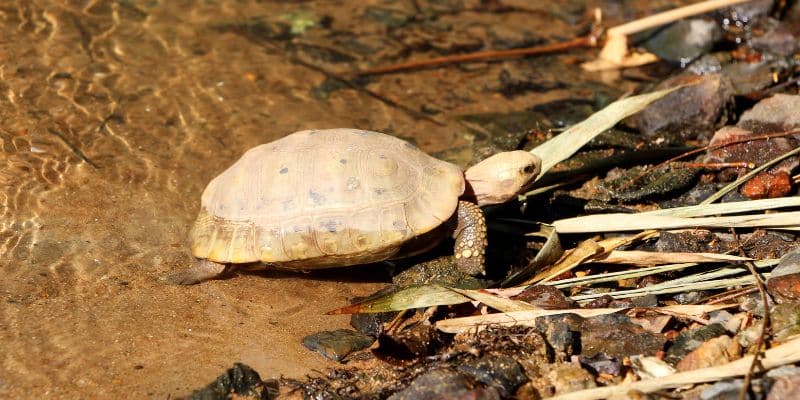
Proper elongated tortoise care requires the keeper to perform a variety of actions on a recurring basis. Some of the most noteworthy things you’ll need to do include:
- Clean the enclosure every day. Be sure to remove any uneaten food and feces, as well as shed skin or scutes.
- Provide fresh, clean drinking water every day. But don’t simply add more water – discard the old water, wash the dish with soap and water, and then refill it completely.
- Monitor the enclosure temperatures every day. Measure the temperature with a digital thermometer; do not guess.
- Mist one side of the enclosure with room-temperature water each morning. Different enclosures will dry at different rates, but most keepers will find it necessary to mist the enclosure on a daily basis.
- Break down and clean the entire enclosure once per month. This includes replacing the substrate (when possible – this isn’t always feasible in outdoor enclosures), disassembling the enclosure cleaning the individual components (again, when possible), and cleaning all the hiding spaces and enclosure furniture.
Handling and Behavior Management
For the most part, elongated tortoises are easy to handle and don’t present many behavioral problems. However, there are a few things keepers will need to understand to have success with the species.
Socialization and Handling
Elongated tortoises are shy, but they generally tolerate regular, gentle interactions with their keepers.
With that said, like most tortoises, they do not enjoy being lifted above the ground. You’ll certainly have to do so from time to time for maintenance and health-inspection purposes, but try to keep such interaction to a minimum. Additionally, be sure to support your tortoise’s weight from below and always use two hands to prevent accidental drops.
As with all tortoises, be sure to wash your hands with soap and water after handling elongated tortoises; they may carry a variety of germs, including Salmonella bacteria.
Behavioral Issues
Elongated tortoises rarely bite or exhibit aggressive behaviors; they’re usually quite tolerant of their keepers. However, they do tend to be shy and spend most of their time hiding. There’s not much that can be done about this, as it is simply part of the animal’s lifestyle.
Do note that these tortoises are more crepuscular than many other species, meaning that their activity levels often peak very early in the morning and late in the evening. They’ll spend the bulk of the day hiding under objects or buried in the leaf litter.
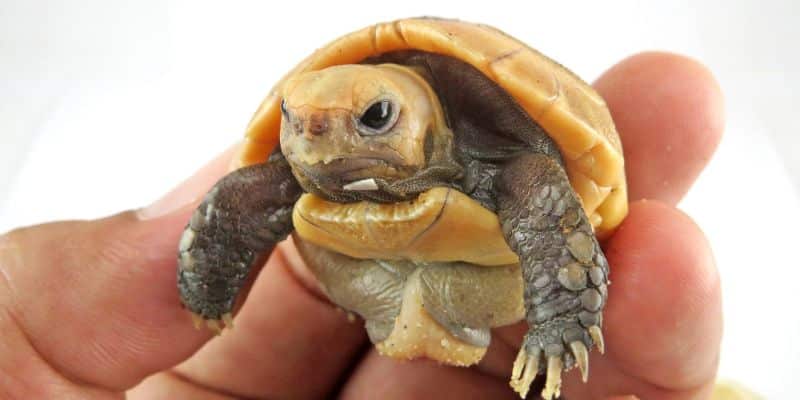
Breeding
Breeding elongated tortoises is generally easy when compared to some other chelonian species.
Pairs or trios consisting of one male and two females are typically housed together all year long. When breeding is desired, keepers will usually initiate a “cool period” of approximately three months, during which the enclosure temperatures are reduced slightly. Some keepers also allow the habitat to dry out a bit during this period.
Once the cool period is completed, normal temperatures are restored. Many keepers also provide a “rainy season” at this time, by misting the habitat frequently. You’ll often notice that male elongated tortoises will exhibit an attractive pink coloration near the eyes and nostrils during this time.
After mating occurs, the female will begin depositing eggs once every month or two. The eggs can then be dug up and incubated at 84 degrees Fahrenheit. They will generally hatch in approximately 100 to 120 days.
The resulting offspring should be reared similarly to the adults, although they will thrive best with slightly higher humidity levels for the first few months of their lives.
Citations
- IUCN Redlist of Threatened Species – Elongated Tortoise
- California Turtle & Tortoise Club – The Elongated Tortoise, Indotestudo elongata
- Reptiles Magazine — Elongated Tortoise Information And Care
- Chelonian Conservation and Biology No. 5 — Indotestudo elongata (Blyth 1854) – Elongated Tortoise, Yellow-headed Tortoise, Yellow Tortoise
